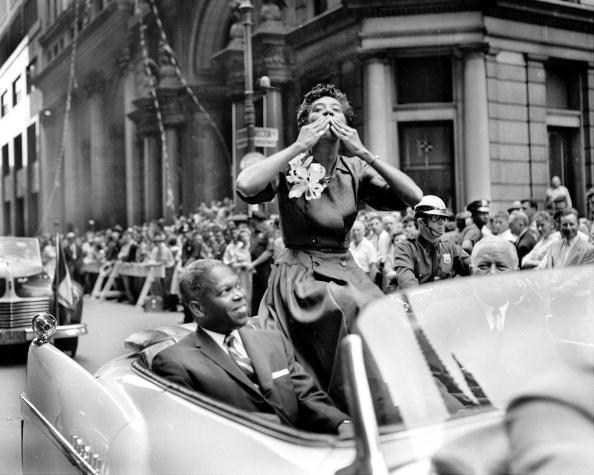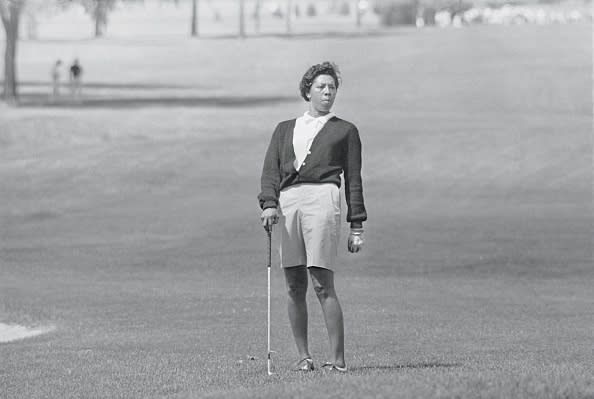Remembering History: Althea Gibson’s legacy lives on more than 50 years since her retirement from pro sports
- Oops!Something went wrong.Please try again later.
- Oops!Something went wrong.Please try again later.
- Oops!Something went wrong.Please try again later.
- Oops!Something went wrong.Please try again later.
- Oops!Something went wrong.Please try again later.
- Oops!Something went wrong.Please try again later.

As Women’s History Month closes, we take a closer look at Althea Gibson, the Black American two-sport athlete whose legacy is still being celebrated even 20 years after her death. It may be 50 years since Gibson last competed in any of her sports – notably tennis and golf — but her presence in venues where she played is still felt.
As recently as last Aug. 25 – on what would have been her 95th birthday – Gibson was honored in New York City with the unique distinction of having a street named after her. The road located at West 143rd Street between Adam Clayton Powell Boulevard and Malcolm X Boulevard is now co-named Althea Gibson Way, honoring the 11-time tennis Grand Slam champion near where she grew up in Harlem.
”It was truly an inspiration for me to watch her overcome adversity,” said tennis icon Billie Jean King, who was just 13 when she first saw Gibson play. ”Her road to success was a challenging one, but I never saw her back down.”
King was on hand in 2019 when the USTA honored Gibson with the dedication of the Althea Gibson Sculpture Garden at the USTA Billie Jean King National Tennis Center. The centerpiece of the garden is a sculpture of Gibson, created by artist Eric Goulder, which includes an augmented reality experience. Developed by MRM/McCann, visitors can activate exclusive content about Gibson’s life and legacy.
RELATED: Ganassi, PNC make push to empower women in racing: ‘Diverse teams yield better results’
“She was beautiful and graceful and intimidating all at the same time on the court,” King added. “When she came to net, she was very intimidating. I’ve said to Venus [Williams] that she was like a 21st-century Althea.”
Born to sharecroppers on a cotton farm in South Carolina in 1927, Gibson’s journey to tennis glory started when she was just a child, growing up in Harlem on a stretch of 143rd Street that had been designated a “Police Athletic League” play area. During daylight hours, the street was barricaded so that neighborhood children could play organized sports. Gibson quickly became proficient in paddle tennis, and by 1939 — at the age of 12 — she was the New York City women’s paddle tennis champion. In 1950, on her 23rd birthday, Gibson made her debut at Forest Hills, becoming first Black athlete to compete in the U.S. National Tennis Championships (the precursor to the U.S. Open).
Her participation received extensive national and international coverage, and Gibson went on to make headlines the next year when she won her first international title, the Caribbean Championships in Jamaica, and later that year became one of the first Black competitors at Wimbledon. Her first of six Grand Slam singles titles came at the 1956 French Open, and she captured three more in 1957, winning the Australian Open, Wimbledon and U.S. Open. Gibson added six Grand Slam doubles titles to her resume as well, highlighted by three straight at Wimbledon.
“Who could have imagined? Who could have thought?” Gibson said in 1988 when she presented her Wimbledon trophies to the Smithsonian Institution’s National Museum of American History. “Here stands before you a Negro woman, raised in Harlem, who went on to become a tennis player … and finally wind up being a world champion, in fact, the first black woman champion of this world,” she said. “And believe it or not, I still am.”
That 1957 season was undoubtedly a highlight, and that year she became only the second Black American, after Jesse Owens, to be honored with a ticker tape parade in New York City. A month later she defeated Louise Brough in straight sets to win her first US Open title, noting: “Winning Wimbledon was wonderful and it meant a lot to me,” she wrote in her autobiography, “But there is nothing quite like winning the championship of your own country.”

In all, Gibson reached the finals of eight Grand Slam events in 1957, winning two singles titles, the Wimbledon and Australian doubles championships and the U.S. mixed doubles crown. She also became the first Black woman to appear on the covers of Sports Illustrated and Time, and her year finished with a streak of 55 matches won on the season.
Gibson kicked off 1958 with two more wins to extend the streak to 57, and additionally that year she defended her Wimbledon and U.S. National singles titles and won her third straight Wimbledon doubles championship — with a third different partner. Additionally, she was the No. 1-ranked woman player in the world in both 1957 and 1958 and was named Female Athlete of the Year by the Associated Press in both years as well.
But late in 1958, having won 56 national and international singles and doubles titles, Gibson retired from amateur tennis. At the time there was no prize money at major tournaments, and direct endorsement deals were prohibited. Players were limited to meager expense allowances, strictly regulated by the USTA.
“The truth, to put it bluntly, is that my finances were in heartbreaking shape,” she wrote. “Being the Queen of Tennis is all well and good, but you can’t eat a crown. Nor can you send the Internal Revenue Service a throne clipped to their tax forms.”
Six years later, after spending time playing exhibition matches and pursuing her career in the music industry, Gibson became the first Black woman to join the LPGA tour. She had begun working with Jerry Volpe at Englewood Golf Club in New Jersey. Volpe was a local legend who gave lessons to several celebrities including Ed Sullivan and Mickey Mantle, and he was shocked by how little money Gibson had earned in tennis, so he gave her an honorary membership at Englewood, where she was the club’s first black member.
Gibson found a welcoming community among the women on tour and a team of advocates ready to have her back in the most discriminating situation. At one event where Gibson had to change her shoes in the parking lot because she wasn’t invited into the clubhouse, all the players changed in their cars in solidarity with her.
“We viewed her as a positive,” LPGA founder Shirley Spork said. “…And she was well liked by the players, accepted by the players. She was a Wimbledon tennis champion, so the gallery would come to see her try to play golf. That was an asset for us because she was a tennis star. Having her out there helped us go forward, to gain more galleries and gain more interest in getting sponsors.”
From 1963 through 1977, Gibson made 171 LPGA starts, and her best finish was a T-2 following a three-way playoff at the 1970 Len Immke Buick Open. She broke course records during individual rounds in several tournaments, and her highest ranking was 27th in 1966. She retired from professional golf at the end of the 1978 season.

“Althea might have been a real player of consequence had she started when she was young”, said Hall of Fame golfer Judy Rankin. “She came along during a difficult time in golf, gained the support of a lot of people, and quietly made a difference.”
She regained her amateur status in 1984 and reportedly enjoyed the game for the remainder of her life. No other black woman matched Gibson’s Grand Slam accomplishments for four decades – until Serena Williams won the U.S. Open title in 1999 and Venus Williams won Wimbledon until in 2000.
“For players like myself and a lot of other African-American players on the tour, Althea Gibson paved the way for us,” Venus Williams said after her U.S. Open debut in Arthur Ashe stadium in 1997 at age 17. “So, it’s important that we recognize this, that I recognize it, and for me to know my history. “
In 2000, after winning the U.S. Open, Venus again recalled Gibson’s accomplishments.
“I knew she was watching when Serena won the U.S. Open and she’s happy to see another black woman win in her lifetime.”
In 1975, Gibson became the state commissioner of athletics in New Jersey, a job she held for 10 years. She then served on the state athletics control board until 1988, and the governor’s council on physical fitness until 1992. But her health and finances declined in the 1990s and it was her former doubles partner, a British player named Angela Buxton, who rallied financial assistance for Gibson. She lived for nearly another decade, dying in September 2003 at age 76.
In 1980 Gibson became one of the first six inductees into the International Women’s Sports Hall of Fame, joining a list of pioneers including Amelia Earhart, Wilma Rudolph, Gertrude Ederle, Babe Didrikson Zaharias and Patty Berg. Other inductions include the National Lawn Tennis Hall of Fame, the International Tennis Hall of Fame, the Florida Sports Hall of Fame, the Black Athletes Hall of Fame, the Sports Hall of Fame of New Jersey, the New Jersey Hall of Fame, the International Scholar-Athlete Hall of Fame and the National Women’s Hall of Fame. In 1991 Gibson became the first woman to receive the Theodore Roosevelt Award, the highest honor from the NCAA.
In her 1958 retirement speech, Gibson noted, “I hope that I have accomplished just one thing. That I have been a credit to tennis, and to my country.”
When her statue was unveiled at Flushing Meadows in 2019, the USTA made a point of confirming Gibson achieved that wish: “By all measures,” reads the inscription on her New Jersey statue, “Althea Gibson certainly attained that goal.”
Learn more about the legendary women who blazed athletic trails in this five-part series, “Remembering History,” as On Her Turf celebrates Black Heritage Month and Women’s History Month with features on Alice Coachman, the 1991 FIFA Women’s World Cup champion U.S. Women’s National Team, tennis great Althea Gibson, race car driver Janet Guthrie and the 50th anniversary of Billie Jean King‘s win over Bobby Riggs in “The Battle of the Sexes.”
More Women's Sports News
Christine Sinclair, soccer’s ‘silent superstar,’ opens up about... Women’s Golf Day founder Elisa Gaudet continues her mission to provide... Li Li Leung talks USA Gymnastics’ cultural transformation, challenges...
Remembering History: Althea Gibson’s legacy lives on more than 50 years since her retirement from pro sports originally appeared on NBCSports.com
